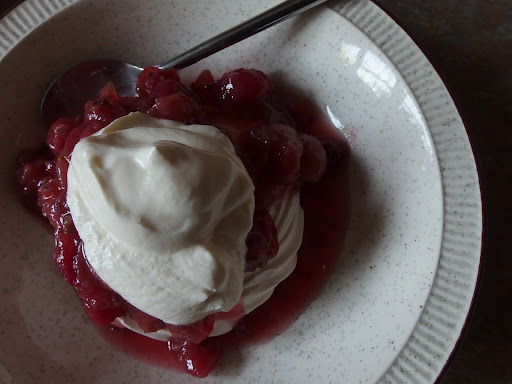Seasonal Recipe: Gooseberry Meringue Nests
It's a fabulous year for gooseberries isn't it? They flowered up at the allotment in profusion, so the bees were very busy around them earlier this year. Their hard work paid off and I have the best crop ever.
I'm growing an older variety called 'Whinham's Industry', which delivers smaller, sweeter berries that are deep red in colour. They cook into a lovely rich, jewel-like sauce, which I've used to make this very simple recipe.
Ingredients (serves 4)
- 12oz gooseberries, topped and tailed
- 4 meringue nests (or you could make your own using half of this recipe)
- A good dollop of half-fat creme fraiche per person - mine came courtesy of winning the fab competition Mark and Gaz hosted recently :)
- Brown granulated sugar to taste (or whatever you have to hand)
- A splash of water
Method
- Place the gooseberries in a pan with a splash of water - you need just enough to make sure the gooseberries don't stick to the pan before they release their juices
- Slowly bring the gooseberries to the boil, stirring until the juices are released
- Turn down the heat to a simmer
- Add sugar to taste - enough to take the edge of any tartness present without masking the rich flavour of the gooseberries. Remember the meringue will add some further sweetness, so you don't need to be too heavy handed
- Simmer the gooseberries for about 5 minutes - until they're thoroughly pulped and you have a sauce that's about as thick as a coulis (there's no need to sieve out the skins and seeds though)
- Leave the gooseberries to cool and then refrigerate for at least a couple of hours, preferably overnight
- To serve, place the meringue nests in the bottom of 4 bowls, add a quarter of the gooseberry sauce to the top of each nest and allow to ooze attractively over the side. Top with a generous dollop of creme fraiche and enjoy!
Variations
- Add a quarter of a pint of custard to the cooled gooseberries and the creme fraiche and mix together thoroughly to make a gooseberry fool. This can be served on its own or with the nests
- Substitute any other seasonal fruit you have to hand, such as raspberries
- Use the gooseberries, creme fraiche and meringues with strawberries to make a variation of Eton Mess
Related Posts
- More seasonal gooseberry recipes (includes an alternative recipe for Gooseberry Fool)
- More puds via my Easy Recipe Finder











Looks so good!
ReplyDeleteIt was! :)
DeleteOh, that looks so very, very good - will look out for 'Whinham's Industry' when I come to buy a gooseberry bush or two come autumn...
ReplyDeleteHi Janet - this is quite an old variety. There are newer varieties which are less prone to mildew (though I've not had any problems with this) and have less spines. However, I can't vouch for their flavour and this variety is extremely good in that department!
DeleteIt's a fabulous year for fruit! We have an abundance of strawberries. Love your recipe, will give it a go :)
ReplyDeleteHi Dee and welcome! Let me know what you think of it :)
DeleteWhat do gooseberries taste like? It is illegal to grow them (and currants as well) in the state where I live, because they are an alternate host to a rust that threatens a state cash crop. I'd like to try the recipe but I have never seen gooseberries in any market here (not surprising), and I wonder what would substitute that might provide a similar taste. I am sure it would be delicious with any fruit, of course.
ReplyDeleteThanks for any tips!
Crumbs - how to sum up the richness of ripe gooseberries? My immediate thought was to try currants, but I see those are banned as well. I'd substitute raspberries, damsons or plums. Damsons in particular have a rich, complex taste when cooked. You'll need more sugar for these and may also want to fish out the skins (as well as the stones) when softening the fruit. You'll also need to cook damsons and plums for a bit longer to release the fruit's juices.
DeleteHow interesting that gooseberries and currants are banned where you are. We had similar rumblings in the press about the domestic growing of potatoes last year as it was suggested that our (possible) poor husbandry was somehow to blame for the potato blight which ravaged the commercial crop. Even if there'd been no GYO spuds grown last year, I doubt it would have helped the commercial crop in last year's poor weather.